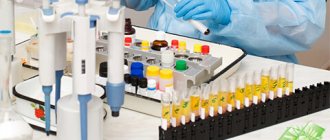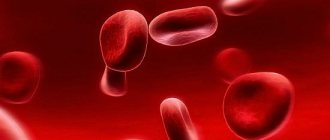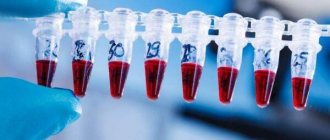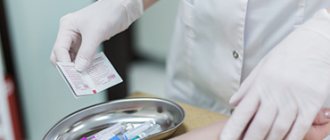" Blood tests
Serology is a science that studies human blood serum and its properties. In modern medicine, this is the name given to one of the branches of immunology, which focuses on the interaction of antibodies and antigens in the patient’s blood serum. Serological reactions themselves, according to their mechanism of action, can be of two types:
- Two-component or direct reaction. This includes the reaction of agglutination and passive hemagglutination.
- Three-component or indirect reaction. In this case, we are talking about a reaction of neutralization or inhibition of hemagglutination.
Serological blood test is an excellent diagnostic method
When they are combined, bacteriolysis, compliment binding reaction, etc. can occur. Serological tests are widely used in both diagnostic and scientific practice.
Determination of blood group, blood and plasma transfusions, determination of protein specificity, monitoring the effectiveness of vaccination and identifying the agent of infection - all this became possible only thanks to serological reactions.
Also, the tasks of serology include the production of various diagnostic and therapeutic sera with constant monitoring of their effect on the patient’s body.
- 2 Enzyme immunoassay blood test
- 3 Advantages and disadvantages
- 4 Interpretation of serological analysis
Indications for use
A serological blood test is necessary to identify the causative agent of the disease if it is difficult to make a diagnosis.
To carry out this reaction, antigens of pathogens are introduced into the plasma, and then the ongoing process is studied by a laboratory assistant. Or they carry out the reverse reaction: antibodies are injected into the infected blood to determine the specific identity of the pathogen.
Scope of application
This research is used in various branches of medicine. This reaction identifies specific cells and antibodies produced by the body to fight infections and viruses.
In addition, a person’s blood type is determined using the serological method.
A similar serological blood test is used in gynecology to diagnose sexually transmitted diseases. This method is also used for comprehensive examinations of pregnant women (detection of toxoplasmosis, HIV, syphilis, etc.). Passing this test is mandatory when registering with a antenatal clinic.
In children, a serological reaction is used to confirm the diagnosis of so-called “childhood” diseases (chickenpox, measles, rubella, etc.) if the symptoms do not have pronounced manifestations and it is impossible to identify the disease by analyzing clinical indications.
Decoding indicators
Only the attending physician interprets the research results. The results are presented on a specialized form according to the form of the medical institution. The quantitative content of microflora microorganisms is taken into account in degrees. The norms for children and adults are different.
| Microorganisms, name | Norms for children under one year old | Norms for adults and children from one year old |
| Bifidobacteria | 1*10 9 or more | 1*10 8 or more |
| Lactobacilli | 1*10 7 | 1*10 6 |
| Escherichia coli | 1-7*10 8 | 3-4*10 8 |
| Pathogenic flora | absent | absent |
| Enterobacter lactose negative | No more than 5% | No more than 5% |
| Cocci from the total number of microflora | No more than 25% | No more than 25% |
Viral and infectious diseases
Serological analysis is actively used by gastroenterologists, hepatologists and infectious disease specialists to diagnose viral hepatitis.
The therapist may also prescribe this test if infectious or viral diseases are suspected. In order to confirm the diagnosis, a serological blood test for parasites is performed to determine specific antibodies. This is done for encephalitis, brucellosis, and allergic reactions.
Deciphering a serological blood test makes it possible to determine the stage of the disease and answer the question of how necessary hospitalization is at the moment. How to prepare properly?
Preparing for the test
Serological blood tests are done in both public and commercial clinics. Preference should be given to a laboratory with modern equipment and qualified personnel.
Biological samples for testing can be saliva and feces, but in most cases the patient's venous blood is used. Blood for a serological test is taken from the cubital vein in a laboratory. Before taking the test, you should consult with your doctor about preparing for this procedure.
To prepare for a serological test, you need to follow a few simple rules.
Blood is donated in a calm state before meals, that is, on an empty stomach. Before this, you should not undergo other tests, such as x-rays, ultrasound, etc.
It is necessary to avoid taking antibacterial and some other drugs several weeks before donating blood. Certain recommendations in this case depend on the disease for which the test is being done. For example, a test for hepatitis involves eliminating fatty foods and alcohol 48 hours before the procedure.
Principles of therapy
If the balance of intestinal microflora is disturbed, complex therapy is prescribed. It is also important to know the cause of this disorder. If opportunistic flora predominates in the analysis results, then the treatment regimen is as follows:
- Antibiotics, but only when the exact pathogen is identified. An additional study of the patient's sensitivity to antibacterial drugs is also prescribed.
- Prebiotics. The use of drugs that help colonize lacto- and bifidobacteria.
- Probiotics. They contain living forms of beneficial microorganisms.
- Immunomodulators and vitamin therapy. To raise and maintain the body's immune strength.
If the analysis reveals a pathogenic flora, the patient is immediately hospitalized in the infectious diseases department and undergoes treatment there. All persons who came into contact with him during the period of illness are also examined.
Fluorescence reaction
Among the types of serological reactions there is a fluorescence reaction. This technique uses a reagent that illuminates antibodies in the blood serum.
Setting up a direct serological reaction involves marking specific antibodies with a fluorescent substance. This reaction is the fastest and is carried out in one stage.
Another option for conducting such an analysis is called indirect, or RNIF. It is carried out in two stages. In the first step, antibodies are not labeled with fluorescent tags, and in the second, appropriately labeled antibodies are used to identify antigens and antibodies. The glow occurs only after binding to a specific antibody occurs.
What does a serological blood test show? The result of the entire procedure is assessed by a special device that analyzes the strength of the radiation and reveals the shape and size of the object under study. The causative agents of infectious diseases are detected with a result whose reliability is 90-95%, depending on the type and stage of the pathology.
Linked immunosorbent assay
These types of serological testing use unique, stable reagents. The marked substances seem to stick to the desired antibodies. As a result, we get a qualitative or quantitative result.
If no pronounced markers are found, the result will be considered negative. If the presence of antibodies in biological samples is detected during a qualitative study, then the test result is considered positive. By quantifying cells, the analysis gives a more accurate result.
By analyzing the analysis indicators (for example, the sum of identified cells), the specialist determines whether the disease is at the initial stage, in the acute stage, or whether the chronic form of the pathology has worsened. In order to make a diagnosis, the doctor takes into account not only the data of a serological study, but also the clinical picture of the disease.
Accounting for results
The result is taken into account by the intensity of the red blood cell sediment in the well.
- “-” negative result, like a negative control sample, in the form of a dense ring at the bottom without any graininess.
- “+” weak intensity of the reaction, a ring at the bottom in the form of a “button”, but individual deposits of red blood cells are visible. The result is described as "questionable". Mandatory blood donation after 2 weeks.
- “++” is the average intensity of the past reaction. The resulting ring at the bottom of the hole is quite wide with a gap in the center. The result is interpreted as weakly positive.
- “+++” intense reaction. In the hole, red blood cells occupy the entire surface and fall out in the form of “umbrellas.” That is, with a thin ring around the periphery. The result is assessed as positive.
- “++++” sharp intensity of reaction. The entire hole is evenly filled with granular deposits of red blood cells, sometimes in the form of an “umbrella”. The result is also considered positive or strongly positive.
The reaction can be false positive when severe autoimmune diseases occur in the human body. Therefore, if, when retaking the test, the reaction crosses and the result is reported as false positive, you should immediately consult a doctor to find out the cause of this reaction.
Features of this test
Carrying out this analysis is not always able to provide 100% confidence that a certain disease has been detected. It happens that the results may be ambiguous and other procedures are required.
For example, during a test for brucellosis, blood serum is controlled for self-retention without antigen. This significantly increases the reliability of testing. A test for brucellosis can be positive or negative, and may also raise doubts.
If you receive questionable results that do not have an unambiguous interpretation, it is recommended to take the test again. In addition, brucellosis can be detected by blood cultures, bone marrow and cerebrospinal fluid examination.
Platelets
Formed elements of blood involved in ensuring hemostasis. Platelets are formed in the bone marrow from megakaryocytes.
An increase in the number of platelets (thrombocytosis) is observed when:
- bleeding;
- splenectomy;
- reactive thrombocytosis;
- treatment with corticosteroids;
- physical stress;
- iron deficiency;
- malignant neoplasms;
- acute hemolysis;
- myeloproliferative disorders (erythremia, myelofibrosis);
- chronic inflammatory diseases (rheumatoid arthritis, tuberculosis, cirrhosis of the liver).
A decrease in platelet count (thrombocytopenia) is observed with:
- decreased platelet production;
- DIC syndrome;
- increased destruction of platelets;
- hemolytic-uremic syndrome;
- splenomegaly;
- autoimmune diseases.
The main function of this blood component is to participate in blood clotting. Platelets contain the bulk of clotting factors, which are released into the blood when necessary (damage to the vessel wall). Thanks to this property, the damaged vessel is clogged by the forming thrombus and bleeding stops.
Pros of serological blood test
Diagnostic techniques using serological reactions are widely used in modern medical practice. This is especially often done when determining viral and infectious pathologies.
The same tests are used during geographic screening and medical examination to prevent the epidemiological spread of infection.
The advantages of the method include:
- High level of confidence.
- Fast reaction and results. The results of the RSC are known within 24 hours. In a special situation, in a hospital setting, the analysis will be ready in a few hours.
- Monitoring the development of the disease and the effectiveness of therapy.
- Low cost and accessibility for patients.
Why is RPGA prescribed for diagnosing syphilis?
Patients often wonder why RPGA is prescribed when syphilis is suspected. Experts say that testing is so popular because in 99% of cases it gives the correct result.
The agglutination reaction will not occur only if there are no treponema antibodies in the body, otherwise the examination will definitely show their presence.
Medical practice shows that the sensitivity of the test is very high, and a positive reaction will be detected even in latent stages of the disease. Thanks to its high performance, the test remains relevant even today.











